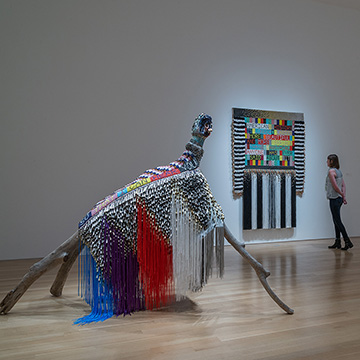Convene
Jeffrey Gibson · Hilary Harnischfeger · Joel Otterson · Lisa Sanditz
This exhibition focuses on four artists, Jeffrey Gibson, Hilary Harnischfeger, Joel Otterson, Lisa Sanditz not traditionally trained in ceramics, but who may incorporate clay into their respective practices/works. Each artist unites varying or disparate materials, references domestic or architectural environments, and often evinces an installation sensibility.
Convene was organized in conjunction with Maker, Mentors and Milestones, the 50th Anniversary Conference of the National Council on Education for the Ceramic Arts (NCECA) in Kansas City, March 16-19, 2016.
The Opening Reception and Lecture will be on March 15, 2016.
Jeffrey Gibson
I am a member of the Mississippi Band of Choctaw Indians and half Cherokee. This is something that I am proud of but it means that I also have had to negotiate what being Native American means to other people all of my life. My work is heavily influenced by the aesthetic histories of many different tribes and specific artists, how that work has been collected and exhibited, and many of my material and format decisions are drawn directly from these histories.
- Jeffrey Gibson
Far from traditional, two hulking, figural sculptures nonetheless emerge from a place of deep heritage for Gibson. With ceramic heads set on spindly wooden frames, these figures are cloaked in blankets, weighed down with tassels, beads, and the neon ribbons and tin jingle cones favored for contemporary powwow dance outfits. Thick beading spells out phrases on the shoulders of the blankets. The jingles, originally invented by the Anishinaabe out of snuff box lids, are here sourced from a powwow regalia company which produces them in Taiwan. Speak to Me in Your Way So I Can Hear You (2015) stands on four wooden legs, red, orange, black and blue glaze pouring down its clay face, Gibson’s points of reference for these ceramic heads are effigy pots from the Mississippian culture, a civilization ancestral to the Choctaw, and he is interested in the alternative history this culture represents. There is a violence to these figures; their eyes weep and holes in their heads open up like visceral orifices, suggesting puncture wounds and bullet holes. The violence recalls another history, that of colonial conquest, which the United States still fails to fully recognize. Gibson, who has worked with collections of Native art at institutions including the Field Museum in Chicago, was once told how to recognize the hole in a hide shirt was made by a bullet. He says these figures come from a traumatic place, yet are cathartic.
- Christopher Green, Hyperallergic, 2015
Hilary Harnischfeger
Harnischfeger’s wall-mounted and free-standing works with their use of clay, plaster, paper, ink, and minerals, continue her exploration of these disparate materials. Steel supports and wooden elements are new additions to the work, along with the introduction of drawing and brushstrokes. Not wanting to directly alter the surface quality of the hydrostone, Harnischfeger subtly cures oil pastel marks, and drawings, onto the ceramic surface itself.
Working out of an old barn located in the northwestern part of the Catskill Mountains, Harnischfeger relied heavily upon that landscape - the barn itself - and her family’s constant presence in those spaces for both material and conceptual inspiration. These sources include the unexpected moments of steep relief, where creeks and rivers have eroded the land, the mortise and tenon joinery and hand-hewn timbers holding the 100-year-old barn together, and her children’s overall fascination with nature and their surroundings.
Referencing both the body and the landscape, these new works tend to be at odds with themselves, both raw and overworked, adroitly crafted and accidental, peaceful and violent. The vertical free-standing pieces are confident in their verticality - but in keeping with Harnischfeger’s inherent contradictions - balanced while threatening to fall over, propped up by metal brackets, or nothing at all. Similarly, the wall-mounted pieces made of heavy ceramics and gemstones become weightless as they float on the wall. “Very well, then I contradict myself, I am large, I contain multitudes,” Harnischfeger’s works, like Whitman said of himself, are inherently in conflict.
Joel Otterson
Artist Joel Otterson’s sculpture is a bricolage of domestic handicraft with traditional sculptural materials, at times blurring the line between high and low culture, art and craft. Copper pipe, woodworking, pottery, concrete, marble, blown glass and needlework are some of the raw materials and techniques that he employs. Otterson has had an ongoing interest in the decorative arts, from its most elegant form in the cabinetry of André-Charles Boulle, and 18th Century Sevres porcelain, to artisanal handicraft and domestic labor, like lawn ornamentation or quilt making. He describes his art practice as “from crochet to welding, and everything in-between.”
When a curator admired Otterson’s ceramic collection of over 200 pieces of American pottery by McCoy, Red Wing, Roseville, Weller, and others, he commented that Otterson should make a sculpture out of the collection, which became the work The American Portable Pottery Museum (1994). The pottery is placed in a structure made of copper plumbing pipe and fittings, organized by color—brown on the bottom like the ground and trunk of a tree, with gradations of natural shades of green, ending in white, suggesting the clouds in the sky. Twenty years later, the renowned curator/collector Beth Rudin DeWoody approached Otterson to make a wall of china out of her eclectic collection of white pottery from the 1920s to the 90s, including unique pieces of Czechoslovakian pottery, amassed over a thirty-year period. Otterson noted that many were of a Modernist flare, and, originally designed to hold floral shop bouquets before the now commonly used disposable plastic vases. The resulting sculpture, The White Wall of China (2014-16) exudes calm, like a white snowcapped mountain or floating cloud, but in its whiteness also suggests the erasure of the functional object.
- Carol Ann Klonarides
Lisa Sanditz
Utilizing both painting and sculpture, Lisa Sanditz continues her exploration of the complicated exchange between commercial modernization and the natural environment in to the three-dimensional realm. Her subjects are drawn from traveling throughout the United States and examining plants and farms, large and small. Through built-up, vibrant painting and expressive cacti sculptures, Sanditz exposes the often wasteful and harmful processes by which our plant and our foods get from farms to our kitchens and gardens.
In the painting Surplus (2014), Sanditz piles corn directly onto the canvas, creating a momentous mountain of gold and orange pieces settled in the middle of a quaint farming town. This is an actual depiction of Wheaton, Minnesota in 2012, when unusually favorable weather resulted in a $17 million glut of corn, which had to be piled up at the local track because the town’s silos couldn’t accommodate all of it. The painting reveals the absurdity of the sheer volume of corn (the equivalent of nearly 160 million cans of it), forcing attention on the farms’ output as well as the scale of production. In the same manner, the crop circles in Pizza Farms (2012) look like endless pie charts, the heaps of jeering, decaying Jack-O-Lanterns in Rotting Halloween (2013) are parts of a large-scale composting field in New York, and the airplanes exhaust in the skies of Crop Dusters (2013) reveal the sum of a day’s pesticide distribution in the hazy air.
If Sanditz sees absurdity in the consumer process of food production, she also finds it in the farming of plants for our meticulously cultivated public and private gardens, as in the cacti farms she visited in Tucson, Arizona. In her array of ceramic interpretations throughout the gallery, the artist exaggerates the physicality of her subjects, imbuing them with creaturely personalities—loopy limbs, red and blue polka-dotted skin, or fluorescent porcupine spikes. But the hat-like Styrofoam cups that drape off their heads are actually used by cacti farmers to keep their appendages from snapping off in the cold seasons: they aren’t a decorative liberty taken by the artist. What appears to be a passerby’s distastefully tossed trash is actually the recycling of synthetic materials to protect these plants, a peculiar intersection of the totally manufactured and the totally organic. It is at this point of incongruity that we are confronted with the disparity between our fairy tale conception of our plants, foods and fields and the manipulated environments that allow our consumerism to thrive.






